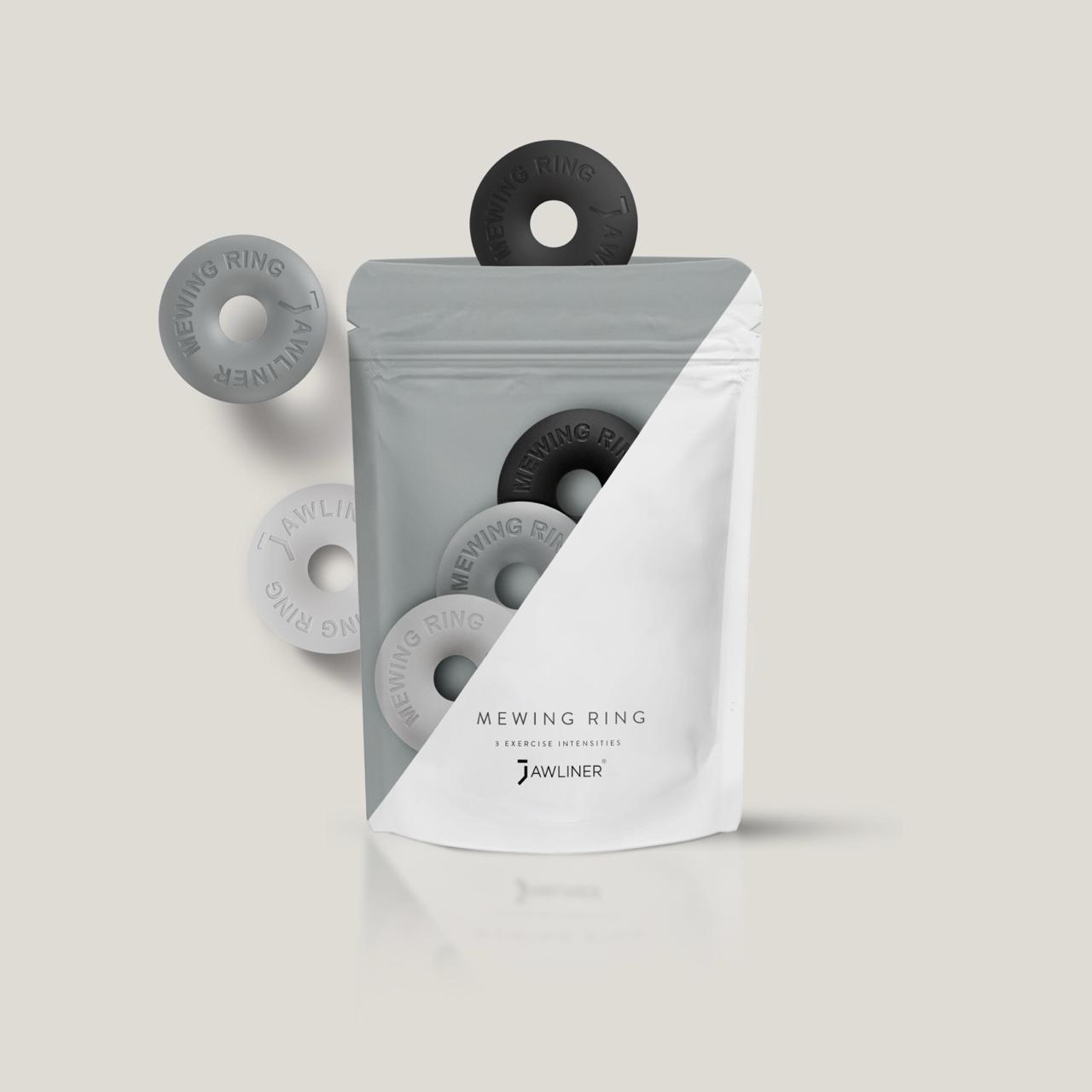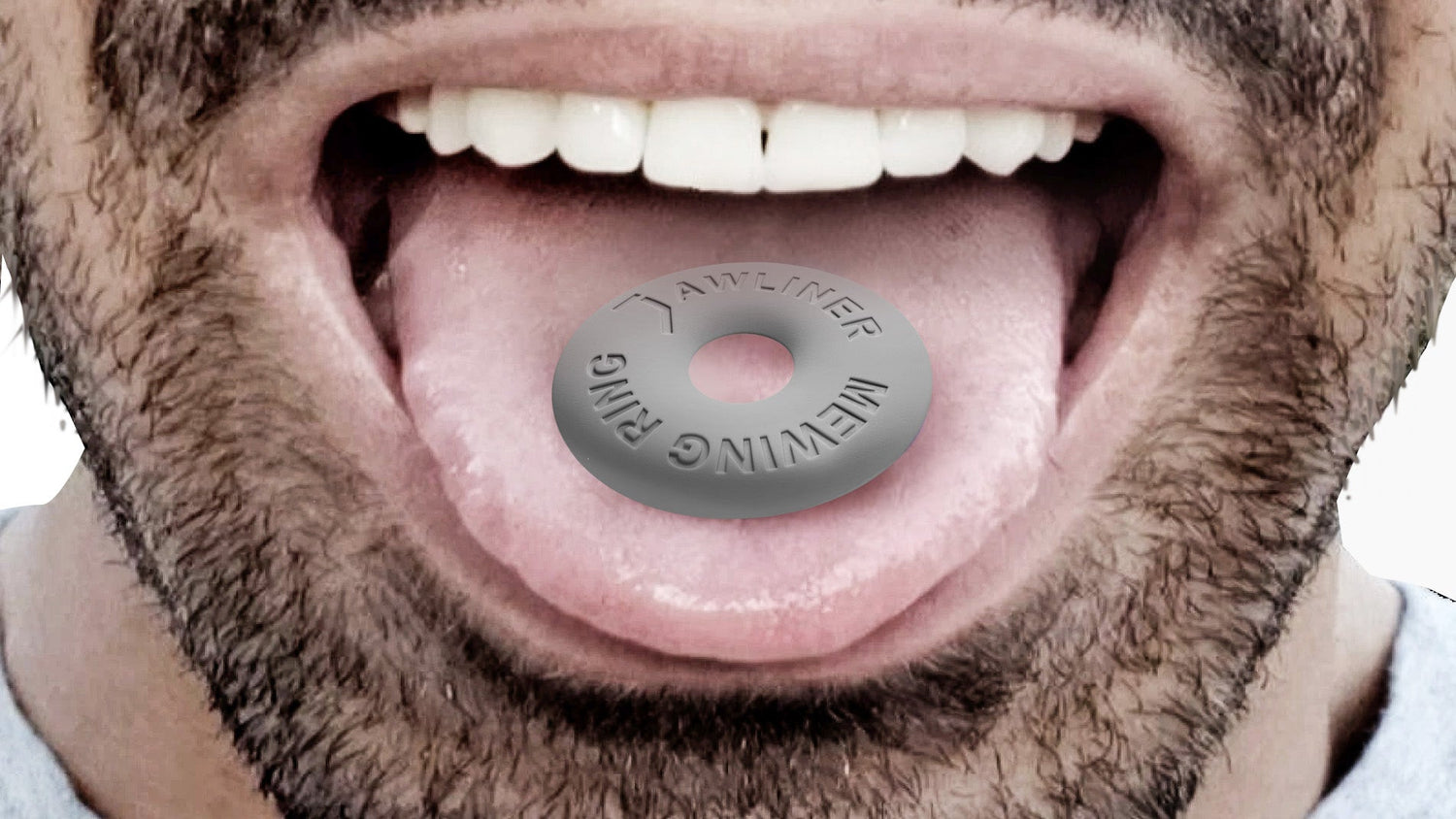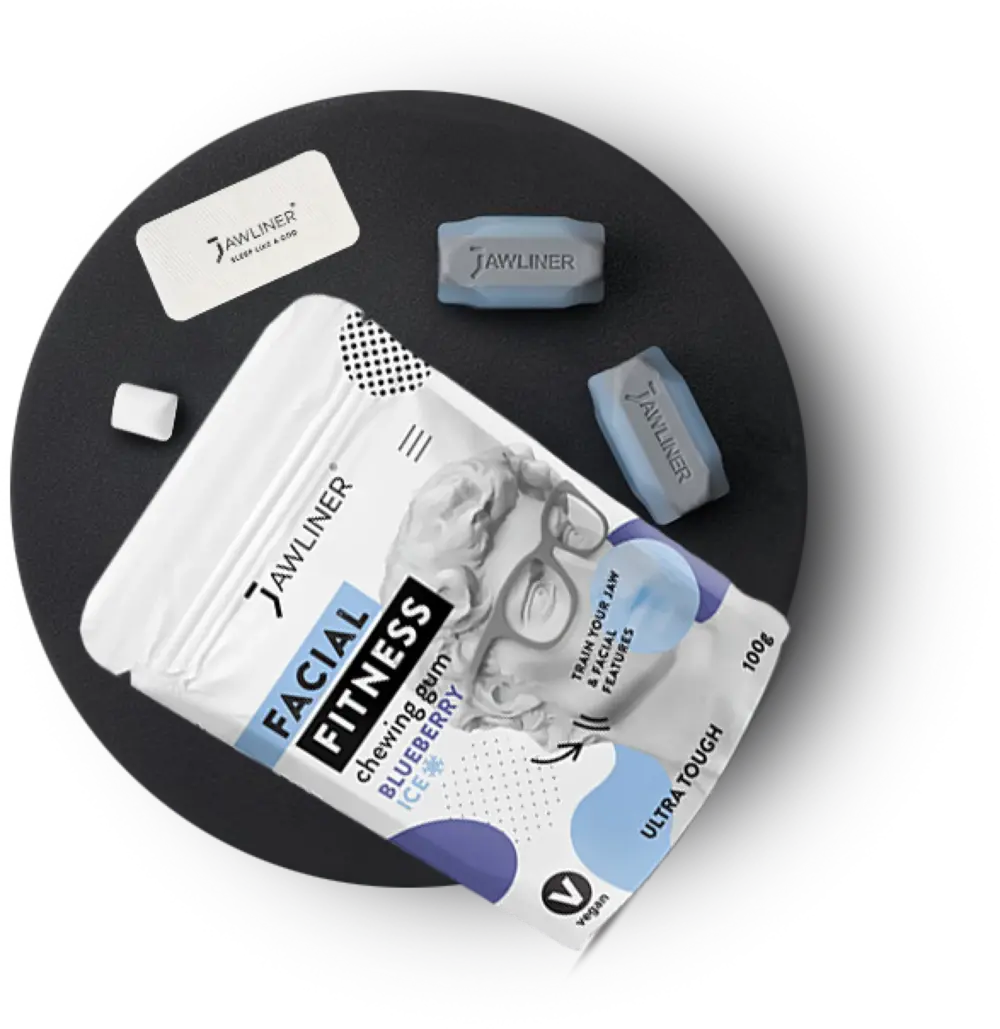Are you curious about this face-shaping hype and wondering if Mewing really works? Don’t worry, we’ll explain what it’s all about.
Mewing isn’t just another trend, but a technique named after the British orthodontist Dr. Mike Mew. Thanks to TikTok and YouTube, it went viral, and many people are trying it to improve their facial profile.
Here you’ll learn:
- what Mewing really is,
- whether the technique actually works,
- how to start Mewing correctly,
- and what risks you should know about.
We debunk myths and show you which aspects of Mewing make scientific sense and what you can realistically expect. Say goodbye to half-knowledge and learn how to naturally optimize your facial contour.
Contents:
- 1. Introduction to Mewing
- 1.1 What is behind the trend?
- 2. What is Mewing?
- 2.1 The technique explained simply
- 2.2 How does Mewing really work?
- 2.3 Why Mewing is relevant today
- 3. When Mewing, correct execution is key
- 3.1 How to do it correctly
- 3.2 Swallowing & nasal breathing – the real lever
- 3.3 Hard Mewing vs. Soft Mewing
- 4. Does Mewing work?
- 4.1 What you can realistically expect
- 4.2 What mewing cannot achieve
- 4.3 Supplement: Scientific evidence on mewing
- 5. Mewing gum & mewing ring
- 5.1 Jawline chewing gum for a stronger jawline
- 5.2 The JAWLINER mewing ring: Precision instead of guesswork
- 6. Are there any risks and disadvantages?
- 6.1 What you should keep in mind
- 7. Tips and tricks for beginners
- 7.1 How to get started with mewing
- 7.2 Additional practical tips for your mewing
- 8. Experience reports and success stories
- 8.1 What others are saying
- 9. Conclusion
- FAQ – Frequently asked questions about mewing & jawline training
1. Introduction to Mewing
1.1 What’s behind the trend?
Mewing has caused a stir on social media, but the basic idea is older than you might think. The technique goes back to Dr. John Mew, who early on explored the influence of tongue posture on facial development. His son, Dr. Mike Mew, developed the concept further and made it famous worldwide – thanks to YouTube videos viewed millions of times.
The observation: Modern habits like soft food and mouth breathing lead to narrower palates and less defined facial features. The correct tongue posture can counteract this trend.
While influencers show impressive before-and-after pictures, so far there is little clinical data to back up all the claims. But let’s take it step by step:
2. What is mewing?
2.1 The technique explained simply
Mewing is essentially about re-learning the natural position of the tongue—at the top of the palate—and maintaining it permanently. It sounds simple, but it can have a positive long-term effect on your facial contours.
The technique comprises these important elements:
- Your tongue lies completely against the upper palate – including the back part
- Your lips remain closed
- Your teeth should lie lightly on top of each other or almost touch
- You breathe through your nose
2.2 How does mewing really work?
Hard food used to shape our chewing system. Lots of chewing → strong chewing muscles → tongue more frequently and firmly against the palate → even upward pressure with each swallow. During the growth phase, this routine formed broader, more angular faces.
Today, we eat softer foods and breathe through our mouths more often. The tongue then tends to lie lower, and there is no even pressure on the palate. The result: narrower, receding jaws are more common.
Mewing is therefore not “active pressing” in everyday life, but rather retraining the natural resting position of the tongue – tongue flat against the palate, lips closed, breathing calmly through the nose. The effect is achieved through habit and correct swallowing, not through force.
Important: In adults, this does not suddenly change the bones. Above all, it improves tongue position, breathing, and perception—this can make contours appear more defined, without promising miracles.
2.3 Why mewing is relevant today
In the past, people had to chew much harder food—meat fibers, roots, unprocessed foods. This put a lot of strain on the chewing muscles, and the tongue was more often on the palate, exerting even upward pressure with each swallow.
Modern diets have changed this: soft foods, industrially processed foods, and early bottle feeding have reduced the strain on the jaw and tongue. At the same time, many people breathe through their mouths more often, for example, due to allergies or a stuffy nose.
The consequences are often narrower jaws, receding faces, and less pronounced contours. This is exactly where mewing comes in: the technique aims to restore the natural resting position of the tongue and reactivate the mechanisms that used to naturally create a more distinctive face.
3. When mewing, proper execution is key
3.1 How to do it correctly
The correct position is the key to success—and often the point where many fail. Pay attention to these details:
- Position your entire tongue flat against the roof of your mouth—it is especially important that the back part is also in contact
- Keep your lips gently closed without tensing up
- Your teeth should lightly touch or be minimally separated
- Breathe only through your nose
Consistency is key! You have to maintain the correct posture throughout the day, not just for a few minutes each day. This requires discipline and patience.
Beginners often find it difficult to remember the correct position all the time. Many also find the posture uncomfortable at first.
Our tip: Set up regular reminders or use certain triggers (such as drinking water) to check your tongue position.
Over time, the correct posture will become a habit, but expect it to take weeks or months, not days. Mewing can be particularly challenging if you have a narrow palate or suffer from breathing difficulties.
3.2 Swallowing & nasal breathing – the real lever
The biggest lever in mewing is proper swallowing.
How to check it:
- Keep your tongue up: When swallowing, the entire tongue remains on the palate – even at the back. No pressure forward against the teeth.
- Stay neutral: Keep your lips loosely closed, your face relaxed, and your jaw back.
- Calm nasal breathing: Breathe in and out through your nose. Mouth breathing disrupts the position of your tongue and makes mewing inconsistent.
Everyday triggers for automation:
Drinking water, climbing stairs, unlocking your cell phone, waiting at traffic lights. Check briefly each time: Tongue up? Lips closed? Nose free?
Typical mistakes that reduce effectiveness:
- Tongue only at the front of the palate, hanging down at the back.
- Swallowing with a forward thrust against the incisors.
- Permanent mouth breathing, especially during stress or at night.
Note: If you find it difficult to position your tongue correctly, a feedback tool such as the JAWLINER Mewing Ring can help you to feel the full contact surface of the palate. It is not a substitute for diagnosis, but it does make the execution much more consistent.

3.3 Hard Mewing vs. Soft Mewing
You often read about “hard mewing” and “soft mewing” in forums. This is not a completely different training method, but rather a question of intensity:
- Soft mewing means holding your tongue gently and permanently against the palate. This is the natural resting position of the tongue, which you are retraining yourself to achieve. It is suitable for everyday use and is the long-term goal.
- Hard mewing means consciously applying strong pressure to the palate – as if you were actively trying to push upwards. This can be strenuous and is only suitable for advanced practitioners. Beginners are more likely to risk tension if they use too much force.
4. Does Mewing work?
4.1 What you can realistically expect
Does Mewing really work? The honest answer: It depends. It all depends on what exactly you expect – and how old you are.
What happens in your body when Mewing
- Tongue position & muscle tension
When Mewing, you press your tongue flat and evenly against the palate – ideally with the entire tongue back. This creates tension in the entire orofacial system, which includes:
- your tongue (e.g., genioglossus, hyoglossus muscles)
- the muscles under the jaw (suprahyoid muscles)
- the chewing muscles like masseter and temporalis
- even supportive neck and throat muscles
This indirectly activates the muscle groups that influence your posture, jawline, and overall facial profile.
- Skull and facial bones
The palate consists of two bone halves connected by a cartilaginous suture (median palatine suture). This suture is still flexible in childhood and adolescence because the cranial sutures are not completely ossified. This is why mewing is most effective during the growth phase.
In adults, however, the sutures are rigid. Active displacement of the bones by tongue pressure alone is then no longer possible.
What you can still expect as an adult
- Improved muscle tone: Especially in the jaw, cheeks, and neck. This can make the face look more defined.
- More nasal breathing: The correct tongue posture promotes nasal breathing, which positively impacts sleep, energy levels, and general health.
- Postural effects: Some feel better head and neck posture over time – which can also improve facial perception.
What Mewing cannot achieve
- No active widening of the palate in adults
- No massive change to the facial bone structure
No “pushing forward” of the upper jaw without medical devices such as MSE or surgery
4.3 Addendum: Scientific evidence on mewing
Although many claims about mewing originate from social media, initial scientific studies support the effect of correct tongue position:
-
Korean Journal of Orthodontics (2014):
In a case study, correcting the tongue position significantly improved an overbite. The result remained stable for many years—even after the retainer was removed. -
Radiology & Oncology (2018):
A study of preschool children showed that consistent tongue rest position can reduce open bites. The technique therefore has a strong effect on the development of the jaw and face, especially during the growth phase.
These studies mainly refer to children and adolescents whose skulls are still growing. There are no large-scale clinical studies for adults as yet. Nevertheless, experience reports and smaller studies suggest that mewing can have positive effects on muscle tension, breathing, and posture.
Summary
In children, Mewing can indeed influence facial growth.
In adults, it provides more muscle tension, better breathing, and posture – and that alone can visibly improve your facial contour, even if it doesn’t deeply change the bone structure.
So if you want a more defined jawline, Mewing helps – but only in combination with discipline, patience, and possibly additional jaw muscle training. Those who want real structural changes need medical support.
5. Mewing Gum & Mewing Ring
5.1 Jawline chewing gum for a stronger jaw profile
Many people dream of having a striking jawline and resort to expensive treatments to achieve it. However, there are also more natural ways to exercise the jaw muscles. JAWLINER Jawline Gum offers you an intense chewing experience for in between meals – without surgery, devices, or aids.

What makes this chewing gum so special?
Our modern eating habits often mean that we consume mainly soft foods. This means that our chewing muscles are used less. This is where JAWLINER Jawline Gum comes in: it is up to 15 times harder than conventional chewing gum and can therefore help to exercise the chewing muscles more – similar to chewing hard, natural foods, but without the extra calories.
Features at a glance:
- Intense chewing experience for the jaw muscles
- Significantly harder than conventional chewing gum
- Natural chewing without invasive measures
- Can be combined with other exercises such as Mewing
- Sugar-free and made from food-safe, safe ingredients
Many users chew Jawline Gum regularly for 15–30 minutes a day, e.g., while working, walking, or relaxing. All you need is the gum and the willingness to actively challenge your jaw.
5.2 The JAWLINER Mewing Ring: Precision instead of guesswork
Many make small mistakes while Mewing – without noticing. This is where the JAWLINER Mewing Ring comes in. It helps you not only learn the correct tongue position but also maintain it over time.
The ring gives you immediate feedback on whether your tongue is positioned correctly – a huge advantage over purely passive methods. Instead of guessing, you feel right away if you’re doing it properly. That makes your Mewing training more effective and structured.
The ring is especially practical: it comes in three resistance levels. This way it adapts to your progress and grows with your training.
What you can expect from the JAWLINER Mewing Ring:
- clean, stable tongue posture
- targeted support in developing a clear jawline
- relaxed jaw and facial muscles
- better posture through conscious mouth tension
- discreet use – at home, in the office, or on the go
6. Are there risks and downsides?
6.1 What you should watch out for
Even though mewing is considered low-risk when performed correctly, there are a few things you should keep in mind:
- Misaligned teeth: Incorrect use can affect the alignment of your teeth, especially if you apply too much pressure. A supportive aid such as the Mewing Ring can help you position your tongue correctly and better control the pressure.
- Muscle discomfort: Beginners often report pain in the tongue and facial muscles. Mild discomfort is normal, but persistent pain is a warning sign!
- Breathing difficulties: If you have been breathing through your mouth, switching to nasal breathing can be challenging at first. Just keep at it!
- Unrealistic expectations: Perhaps the biggest risk—many people develop completely exaggerated ideas due to spectacular “before and after” pictures on social media.
- Lack of guidance: Here, too, the Mewing Ring can help you find the correct tongue position. However, without professional advice, you may overlook underlying mouth or jaw problems.
Many people choose a gradual approach to slowly get used to the exercise. Pay attention to your body: if you feel pain or discomfort, you should stop the exercise and consult a medical professional if in doubt.
7. Tips and tricks – Mewing guide for beginners
7.1 How to start Mewing properly
Starting with Mewing can be a bit challenging, but with these tips, the new tongue posture will become a habit more quickly:
- Find the correct starting position: Make the “N” sound to find the correct spot for your tongue tip – just behind the upper front teeth. Then flatten the rest of your tongue against the palate.
- Take it step by step: Start with short sessions (15–20 seconds) several times a day and gradually increase the duration.
- Use visual guides: YouTube videos from credible sources can help you visualize the correct technique.
- Set reminders: Set phone alarms or link checking your tongue position to everyday routines like drinking water. Even easier with the JAWLINER Mewing Ring, which gives you instant feedback.
- Practice proper swallowing: When swallowing correctly, your tongue presses up against the palate, not forward against the teeth.
- Combat mouth breathing: If you breathe through your mouth, especially at night, identify and address the causes such as nasal congestion.
- Document your journey: Take regular photos from consistent angles to track changes objectively.
- Stay patient and consistent: Results develop over months or years, not days or weeks.
- Pay attention to your posture: Proper neck and back posture can influence the effectiveness of Mewing.
- Consult experts if necessary: If you experience pain or are unsure, speak to a dentist or orthodontist.
Start with realistic expectations and focus on the correct technique – don’t force yourself into positions that cause discomfort.
7.2 Additional practical tips for your mewing
- N-sound technique: Say the sound “N” several times with emphasis. The tip of your tongue will then automatically be in the correct position directly behind your upper incisors. From there, you can roll your tongue flat against the roof of your mouth.
- Regular triggers: Link mewing to small everyday moments. Examples: every time you drink water, when your cell phone vibrates, or when you are stopped at a red light. This will train your muscle memory.
- Chewing gum for the chewing muscles: Hard chewing gum such as JAWLINER Jawline Gum works your masseter muscles much harder than normal chewing gum. This further supports the training effect – similar to hard food in the past.
-
Practice swallowing correctly: Make sure that your tongue presses upwards against the roof of your mouth when swallowing, not forwards against your teeth. This is the only way to build up the desired pressure on the roof of your mouth.
- Avoid mistakes: Many people make the mistake of placing their tongue only at the front of the roof of their mouth. It is important that the back of the tongue also makes contact.
8. Testimonials and success stories
8.1 What others report
Social media is full of testimonials about Mewing – ranging from subtle improvements to dramatic jawline changes.
Commonly reported experiences include:
- Defined facial contours: Many users report a more pronounced jawline and a more defined face after months of practice.
- Better breathing and sleep: A common benefit is improved nasal breathing and reduced snoring. Many report better sleep and less dry mouth in the morning.
- Improved posture and confidence: Beyond physical changes, many report better posture and increased self-confidence.
- Varied results: Some see changes within months, others notice more subtle improvements over longer periods.
- Positive side effects: Many say Mewing motivated them to adopt other healthy habits – like better posture, regular exercise, and mindfulness.
9. Conclusion
Mewing is not a miracle cure, but a way to consciously pay attention to your tongue position and thus your facial and jaw awareness. Many users report that they notice changes through regular practice.
Important: Mewing requires patience, correct technique, and regular practice. Whether and what changes become visible can vary greatly from person to person.
In combination with complementary exercises or tools such as the JAWLINER Jawline Gum or the Mewing Ring, the training can be made more varied.
So: no pressure, no hype – just practice consciously, execute correctly, and remain patient.
The most important points at a glance:
- Basic concept: Mewing means holding your tongue flat against the roof of your mouth and breathing through your nose with your lips closed in order to improve your facial structure in the long term.
- Scientific status: Although correct mouth posture is healthy, changes in adults have not been scientifically proven. The situation is slightly different when chewing harder foods: this has been shown to put more strain on the chewing muscles, which can lead to better muscle tone. If you don't want to eat hard food all the time, you can use Jawline chewing gum.
- Practical application: Success requires consistency, patience, and the right technique – it takes weeks or months for the posture to become a habit.
- Safety: When performed correctly, mewing is low-risk, but incorrect technique could lead to problems. If you are unsure, consult an expert.
- Realistic expectations: Do not expect dramatic transformations. However, moderate improvements in muscle tone and subtle structural changes are possible.
FAQ – Frequently Asked Questions about Mewing & Jawline Training
Is mewing safe?
Yes, if done correctly and without excessive force. Listen to your body and stop if you experience persistent pain.
How long does it take to see results?
It depends on age, genetics and consistency. In children changes can appear more quickly, while in adults it can take months or even years to see noticeable improvements.
Can mewing replace orthodontic treatment?
No, mewing cannot replace medical treatments in case of malocclusions or serious orthodontic issues. Always consult a professional in these cases.
Does mewing work at night too?
Ideally yes, but during sleep it’s harder to maintain the correct position. Daytime practice helps make it more natural at night as well.
Can I combine mewing with other exercises?
Absolutely! Neck exercises, chewing Jawline Gum and using the JAWLINER Mewing Ring can enhance the results.






